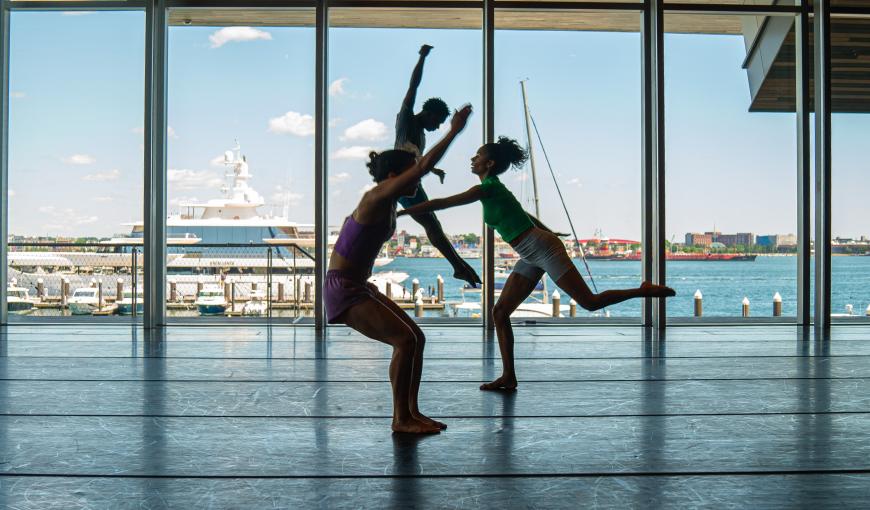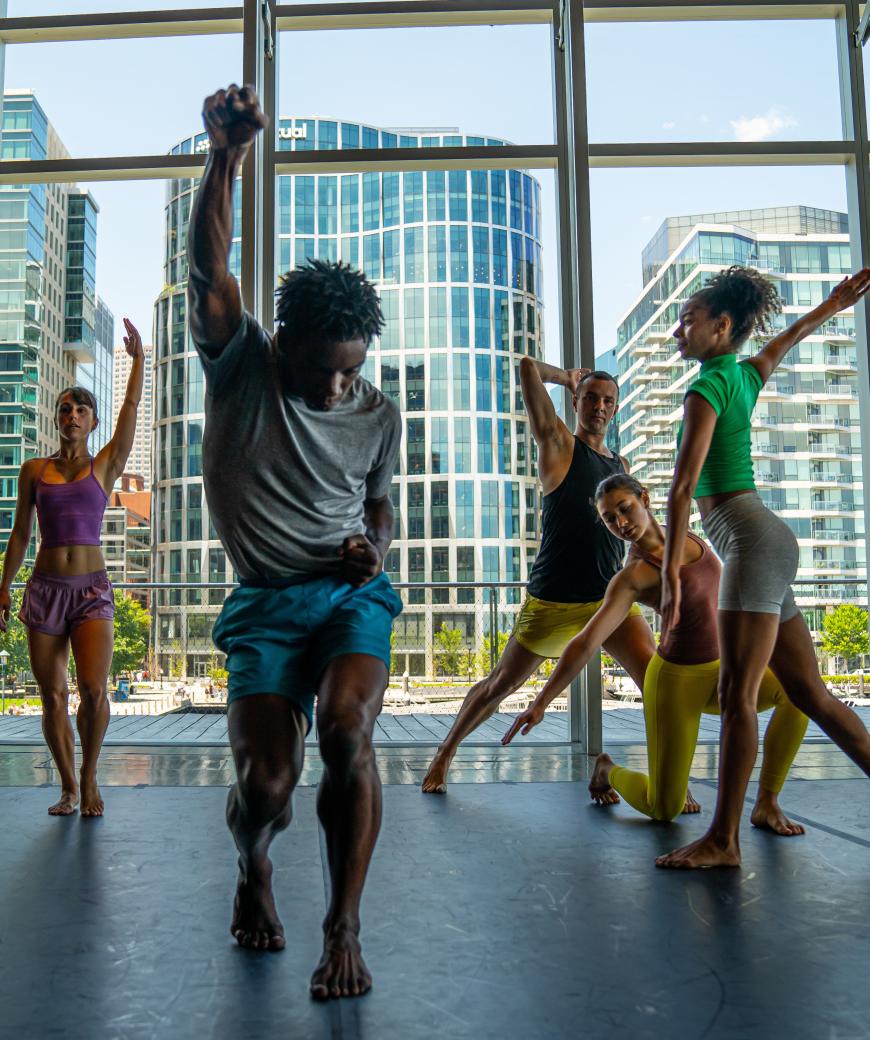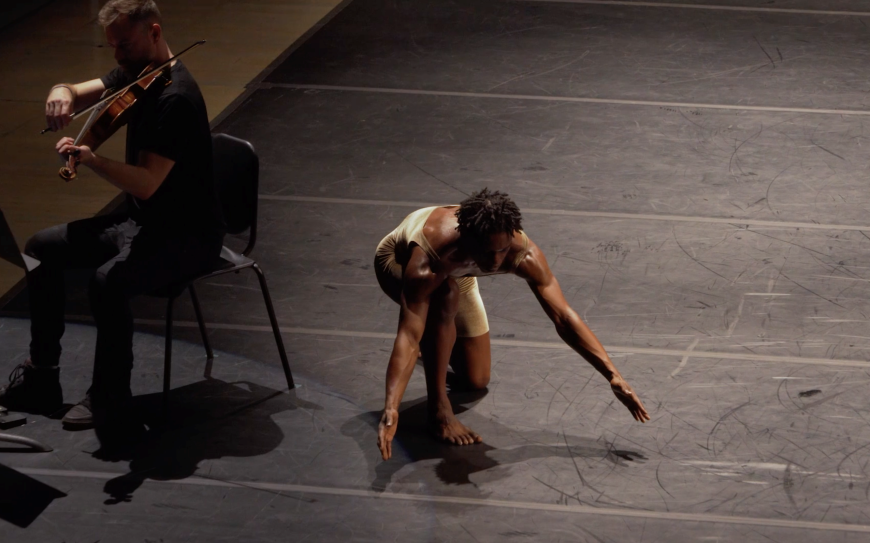
Every two years, the Rubin Institute for Music Criticism convenes in San Francisco, teaching music students across the U.S. about music journalism. SF Classical Voice has partnered with the Rubin Institute to give the program’s top writers more experience in the field with an internship. This year’s Rubin winners, Emery Kerekes and Lev Mamuya, will be with SFCV for six months, reporting from New York and Boston, respectively.
Site-specific art, when well executed, reminds us that all art is deeply influenced by the time, place, and circumstances of its creation. The Institute of Contemporary Art’s Summer Stages Dance program, for eight years a jewel of Boston’s contemporary arts programming, often prompts choreographers and composers to engage deeply with its home space, the Barbara Lee Family Foundation Theater, as an element of the creative process. And it’s quite the space on which to meditate — despite its obfuscation from street view due to a yearslong flurry of fast-encroaching developments, the ICA is a striking meeting place of soft-toned wood, metal, glass, and water.
Harbor, a piece choreographed by Liz Gerring for her company to Waves and Particles, a score from the illustrious composer and eco-philosopher John Luther Adams, reached new heights in its consideration of the space, itself a meditation on the surrounding harbor and its history. Eliciting both universal and site-specific reflections on wind, water, travel, and nautical forms, this collaboration proved to be one of the most well-integrated collections of elements to grace the theater since the inception of the Summer Stages program.

From the work’s opening moments, its gestation on-site was clear. Standing plinth-like amongst the pillars that frame stage right’s harbor view, the dancers emerged from a place of formal mimicry before setting themselves in motion. Gerring played often with ideas of stillness and motion in her choreography. While some dancers struck architectural poses in the background (evoking sails, masts, and more), framed against the vertical rafters at the back of the space, others executed running, rolling, or flowing gestures (at different points desperate, determined, and aquatic) in the foreground, in conversation with horizontal tape lines running across the stage. Gerring used the contrasting elements of this vocabulary to highlight different dancers’ strengths. McCall Atkinson was powerfully emotive in the piece’s fluid gestures and seemed the group’s chief storyteller in moments, while Mariah Anton’s angular work in the stage-left foreground possessed impressive confidence and swagger.
In duo and trio moments, Gerring allowed her registers of stillness and motion to interact fully, while referencing contemporary dance traditions. Whether performing swinging, strutting walks side by side or lifting each other balletically, the partnering read like bold text, distilling gestures that had developed over the past few minutes and introducing new elements that would emerge in the following sections. Gerring writes of her passion for abstraction in her biography, but these moments gave the work’s many elements a satisfying sense of rigorous, internal logic. Cemiyon Barber, displaying physicality and elegance in equal measure, sparkled in several of these interludes.
Adams’s Waves and Particles was similarly concerned with contrasting models of motion, as evidenced by its title. Consisting mostly of drone and perpetual motion textures, it uncovered substantial depth from both these registers alone and set against each other. Shorter notes appeared alternately garrulous and wistful, long tones ranged from the serene to the hideously oily. Finally, well-timed grand pauses allowed the sounds of the dancers’ movements (long, sliding squeaks, quick footfalls, and short, emphatic breaths) to contribute to the soundscape as rhythmic instruments.

The JACK Quartet approached Adams’s palette with admirable maturity. While the score may have sounded monotonous in the hands of less-skilled players, JACK plumbed the work’s nuance and quiet invention. From the outset, cellist Jay Campbell anchored the group’s timbre. His tuned-down lowest string, alternately dusky and hefty at appropriate moments, provided the base upon which his collaborators created a range of textures. Violinist Christopher Otto found moments of genuine, piercing invention in his open-stringed drone playing. Suspended in a simple spotlight in the foreground to stage right, JACK delivered a performance without ego that allowed the Gerring Company dancers to move about Adams’s score and its sense of time. Even with dancers launching themselves pleadingly at the quartet’s spotlight in several moments, JACK always cut cool and collected figures.
Gerring and Adams’s meditation in Harbor operates on a massive scale without being severe. It is quiet, nuanced, and genuinely earnest, evoking and questioning its promised thematic imagery with real substance. On Saturday night, the Boston harbor performance felt not only site-specific but site and moment-dependent, as if it could only happen in that room, with those performers. As the plush orange seats emptied, that feeling began to fade. It’s a good thing — this piece deserves numerous restagings, built for harbors elsewhere.



